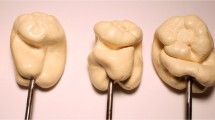Summary
Perceptual organization during short tachistoscopic presentation of stimulus patterns formed by ten moving bright spots, representing a human body in walking, running, etc. was investigated. Exposure times were .1 sec to .5 sec.
The results reveal that in all Ss the dot pattern is perceptually organized to a “gestalt”, a walking, running, etc., person at an exposure time of .2 sec. 40% of Ss perceived a human body in such motion at presentation times as short as 0.1 sec. Under the experimental conditions used the track length of the bright spots at the threshold of integration to a moving unit was of the size order 10′ visual angle.
This result is regarded as indicating that a complex vector analysis of the proximal motion pattern is accomplished at the initial stage of physiological signal recording and that it is a consequence of receptive field organization. It is discussed in terms of vector calculus.
Similar content being viewed by others
References
Börjesson, E., von Hofsten, C.: Spatial determinants in depth perception in two-dot motion patterns. Perception and Psychophysics, 11, 263–268 (1972)
Börjesson, E., von Hofsten, C.: Visual perception of motion in depth. Applications of a vector model to three-dot motion patterns. Perception and Psychophysics, 13, 169–179 (1973)
Johansson, G.: Perceptual overestimation of small motion tracks. Psychol. Beitr., 6, 570–580 (1962)
Johansson, G.: Geschehenswahrnehmung. Handbuch der Psychologie, Bd 1, 745–775. Berlin-Heidelberg-New York: Springer 1966
Johansson, G.: Visual perception of biological motion and a model for its analysis. Perception and Psychophysics, 14, 201–211 (1973a)
Johansson, G.: Monocular movement parallax and near-space perception. Perception, 2, 135–146 (1973b)
Johansson, G.: Projective transformations as determining visual space perception. Perception: Essays in Honor of J.J. Gibson, (Ed. by R.B. MacLeod and H.L. Pick, Jr.) Ithaca, N.Y.: Cornell University Press 1974a
Johansson, G.: Vector analysis in visual perception of rolling motion. Psychol. Forsch., 36, 311–319 (1974b)
Johansson, G.: Visual perception of rotary motion as transformations of conic sections. Psychologia, Vol. XVII, No. 4, 226–237 (1974)
Johansson, G., Jansson, G.J.: Perceived rotary motion from changes in a straight line. Perception and Psychophysics, 4, 165–170 (1968)
Neisser, U.: Cognitive Psychology, New York.: Wiley 1967
Author information
Authors and Affiliations
Rights and permissions
About this article
Cite this article
Johansson, G. Spatio-temporal differentiation and integration in visual motion perception. Psychol. Res 38, 379–393 (1976). https://doi.org/10.1007/BF00309043
Received:
Issue Date:
DOI: https://doi.org/10.1007/BF00309043




